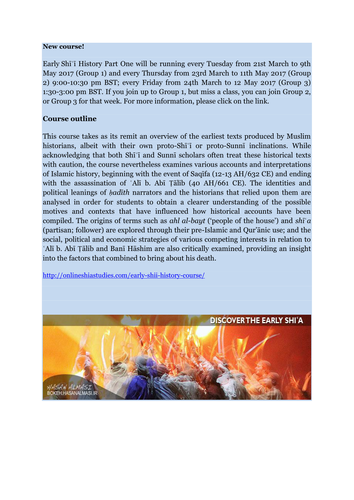
Course outline
This course takes as its remit an overview of the earliest texts produced by Muslim historians, albeit with their own proto-Shīʿī or proto-Sunnī inclinations. While acknowledging that both Shīʿī and Sunnī scholars often treat these historical texts with caution, the course nevertheless examines various accounts and interpretations of Islamic history, beginning with the event of Saqīfa (12-13 AH/632 CE) and ending with the assassination of ʿAlī b. Abī Ṭālib (40 AH/661 CE). The identities and political leanings of ḥadīth narrators and the historians that relied upon them are analysed in order for students to obtain a clearer understanding of the possible motives and contexts that have influenced how historical accounts have been compiled. The origins of terms such as ahl al-bayt (‘people of the house’) and shīʿa (partisan; follower) are explored through their pre-Islamic and Qur’ānic use; and the social, political and economic strategies of various competing interests in relation to ʿAlī b. Abī Ṭālib and Banī Hāshim are also critically examined, providing an insight into the factors that combined to bring about his death.
http://onlineshiastudies.com/early-shii-history-course/
This course takes as its remit an overview of the earliest texts produced by Muslim historians, albeit with their own proto-Shīʿī or proto-Sunnī inclinations. While acknowledging that both Shīʿī and Sunnī scholars often treat these historical texts with caution, the course nevertheless examines various accounts and interpretations of Islamic history, beginning with the event of Saqīfa (12-13 AH/632 CE) and ending with the assassination of ʿAlī b. Abī Ṭālib (40 AH/661 CE). The identities and political leanings of ḥadīth narrators and the historians that relied upon them are analysed in order for students to obtain a clearer understanding of the possible motives and contexts that have influenced how historical accounts have been compiled. The origins of terms such as ahl al-bayt (‘people of the house’) and shīʿa (partisan; follower) are explored through their pre-Islamic and Qur’ānic use; and the social, political and economic strategies of various competing interests in relation to ʿAlī b. Abī Ṭālib and Banī Hāshim are also critically examined, providing an insight into the factors that combined to bring about his death.
http://onlineshiastudies.com/early-shii-history-course/
Something went wrong, please try again later.
This resource hasn't been reviewed yet
To ensure quality for our reviews, only customers who have downloaded this resource can review it
Report this resourceto let us know if it violates our terms and conditions.
Our customer service team will review your report and will be in touch.
£0.00
